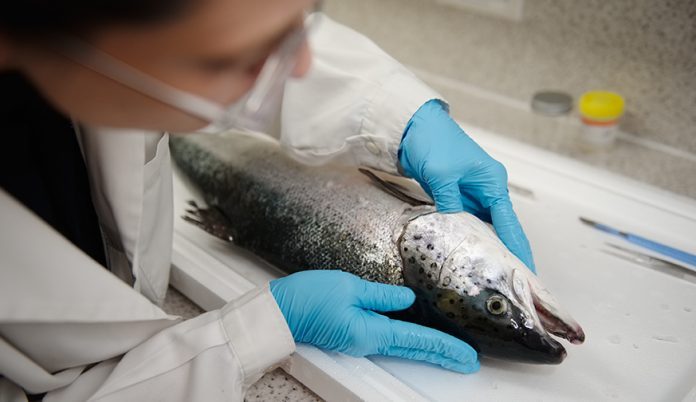Two Scottish consortiums, backed by the Scottish Aquaculture Innovation Centre (SAIC), are embarking on initiatives to fight one of the industry’s most significant challenges.
In a press release the SAIC said that the projects will bring together the expertise of Scotland’s Rural College (SRUC), the Roslin Institute (part of the University of Edinburgh), Loch Duart and Landcatch Natural Selection, a salmon breeding business and part of Hendrix Genetics.
Who’s who
Another ten organisations, including The Scottish Salmon Company and Grieg Seafood Shetland, Mowi, Cooke Aquaculture Scotland, Mowi, Wester Ross Fisheries, Nevis Marine, and the Scottish Salmon Producers’ Organisation will also contribute to the first consortium. consortiums. Their work will complement an £800,000 SAIC co-funded project announced in April 2018, which is aiming to develop new feeds to promote salmon health and devise diagnostic tools for monitoring gill health.

Combining the consortium’s expertise, skills, and data, the first project is taking an innovative and unique approach to explore the factors which can cause gill damage or disease to occur – such as the local environment, water quality and temperatures, as well as nutrition, farming practices, and equipment – while also examining how better to prevent and control the condition.
The second project, examining genomic breeding for gill health and lice resistance in salmon, is being undertaken by Landcatch Natural Selection, Noahgene Ltd, the Roslin Institute at the University of Edinburgh, the University of Stirling’s Institute of Aquaculture, and SAIC.
Scotland is the third largest producer of salmon in the world, according to recent figures from the Scottish Government. In 2017 the industry produced 189,707 tonnes.
Impaired gill health
However, in the last few years, impaired gill health has become a major challenge in an ever-changing natural environment, accounting for substantial losses of fish.
Robin Shields, Senior Aquaculture Innovation Manager at SAIC, said: “Gill health is up there with sea lice as one of the biggest challenges facing salmon farming, not only in Scotland, but across all salmon-producing countries. This is an internationally significant issue, which we’re aiming to address through this focussed effort from some of the top minds in the field.
“The health of a fish’s gills is absolutely critical to its overall wellbeing. The outcomes we are looking for from these projects are to help provide the industry with the knowledge and tools it needs to manage and control outbreaks, and – further down the line – to prevent disease as far as we can by breeding fish with greater natural resistance.”
Giada Desperati, Research and Development Coordinator at Loch Duart, said: “Rising water temperature is adding to the gill challenges facing our salmon. Ensuring the best possible health and welfare for our fish is massively important to our company. Not only is Loch Duart investing heavily in new technology to counteract this problem, but we welcome with open arms the opportunity to work together with other salmon farmers on this important health issue.
“Our industry is resilient and innovative and, in collaboration with the SRUC, we are confident that this project will improve understanding, prevention and control for gill health challenges.”
Most important challenges to the salmon industry worldwide
Alastair Hamilton, Senior Geneticist at Landcatch Natural Selection, added: “Amoebic Gill Disease (AGD) is emerging as one of the most important challenges to the salmon industry worldwide, with treatment costs presenting a substantial financial burden to the industry. Since introducing genomic selection as a means to enhance resistance to AGD in 2014, Hendrix Genetics has demonstrated that the use of this technology can substantially accelerate genetic progress compared to conventional breeding programs, with evidence suggesting gains are both cumulative and permanent.
“A significant constraint on wider deployment of this technology is the cost of genotyping. Although Hendrix Genetics has introduced innovations to tackle this, cost remains a significant obstacle. In this project, we will develop and apply methods to further improve the cost-efficiency and the accuracy of selection for disease resistance.
“The University of Edinburgh’s Roslin Institute, University of Stirling’s Institute of Aquaculture, and Landcatch have an exemplary track record in collaborating to develop industry-relevant innovations, and we believe that progress achieved through this project will be of benefit across the salmon industry in Scotland and beyond,” he added.

